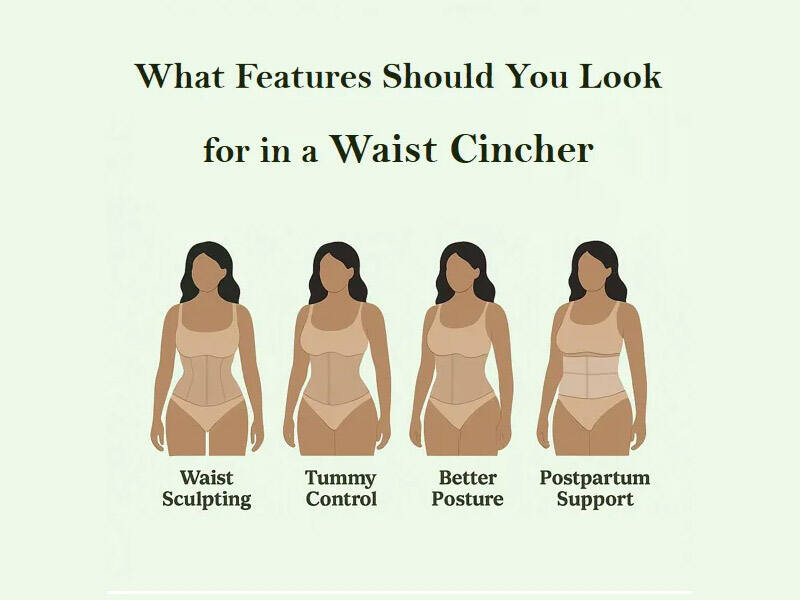
Definition and Primary Function of a Waist Trainer
Waist trainers are basically tight compression garments meant to reshape the middle area by pressing on the stomach and lower back regions. What they do has two main parts really. First, they temporarily make waists look smaller by shifting soft tissues around. Second, they help with posture because the pressure supports the spine in a better position. These aren't just regular shapewear items that flatten out bumps though. Waist trainers actually try to change how the torso looks while being worn, making it appear slimmer. But when someone takes them off, the body goes back to normal pretty quickly. Most of these garments have stiff boning similar to corsets or strong elastic sections throughout to keep everything compressed properly. Some brands even add extra layers for stronger hold in problem areas like the hips or under the bust line.
The Science of Compression: How Waist Trainers Reshape the Torso
Waist trainers work by applying constant pressure all around the body, which temporarily squishes the fat under the skin and pushes the stomach organs upwards, giving that classic hourglass look people want. According to research published last year in biomechanics journals, most average quality waist trainers apply between 10 to 15 mmHg of pressure, enough to actually shrink someone's waist measurement by about an inch and a half to two inches while wearing them. But here's the catch - once those things come off, everything bounces back pretty quickly. The fat cells puff back up and the organs settle down where they belong. Another thing worth mentioning is how these tight wraps can restrict the diaphragm from expanding properly. This makes people breathe more shallowly through their chests rather than deeply into their bellies, which some folks report feels like their whole torso gets tighter when they wear them for extended periods.
| Compression Type | Pressure Range | Duration of Effect | Common Materials Used |
|---|---|---|---|
| Light Elastic | 5–10 mmHg | 1–3 hours | Spandex, Nylon |
| Moderate Boning | 10–15 mmHg | 4–6 hours | Steel, Polyester |
| Heavy Restriction | 15–20 mmHg | 6–8 hours | Leather, Latex |
Common Types: Corsets, Cinchers, and Neoprene-Based Trainers
Three dominant designs dominate the market:
- Steel-Boned Corsets: Rigid structures with vertical metal supports, modeled after historical garments, offering maximum compression for formal wear
- Elastic Cinchers: Flexible, hook-and-eye designs using medical-grade latex for all-day waist training regimens
- Neoprene Wraps: Sweat-inducing thermal belts marketed for gym use, claiming to amplify calorie burn during workouts
Each type prioritizes different outcomes—corsets for dramatic shaping, cinchers for gradual training, and neoprene for athletic recovery.
Achieving an Hourglass Figure with Daily Waist Trainer Use
Waist trainers work by squeezing the middle area, which gives that hourglass look right away as they push soft tissues both up and down the body. Most people need to wear them for around 8 to 12 hours each day to see results, though some folks say their waist gets smaller by about 2 or even 3 inches after wearing one consistently for several weeks. But there are limits to what these garments can do because our bones don't actually change shape. Rib cages differ from person to person in how flexible they are, so anyone who tries this will find that their figure goes back to normal once they take off the trainer.
Immediate Visual Slimming and Waist Reduction Explained
Waist trainers work by compressing the area around the midsection, pushing fat and internal organs slightly out of place which creates the illusion of a narrower waistline. Think of it kind of like regular shapewear, except these have much sturdier boning built in to create those dramatic hourglass shapes people want. According to some research published back in 2022 from the Journal of Orthopaedic Research, folks wearing these kinds of compression garments saw their waists shrink by about 1.8 inches while they were on - similar actually to what happens when someone wears those medical braces designed to correct posture issues. But here's the catch: once the person takes off the trainer, everything goes back to normal pretty quickly since our bodies tend to bounce right back to where they were before all that squeezing happened.
Can Waist Training Deliver Permanent Shaping? Evidence Review
There's actually no solid research backing up claims that waist trainers alone lead to lasting waist reductions. Some limited data points to people who wear them every day for at least six months alongside core exercises might keep around half an inch to an inch smaller after they stop using them. Most experts think this effect comes from muscle memory rather than actual bone structure changes. The American Council on Exercise has warned though that keeping the waist compressed for too long could actually make core muscles weaker over time, which might cancel out whatever temporary results someone gets.
Waist Trainers and Weight Loss: Separating Myth from Medical Reality
Many consumers purchase waist trainers believing they’ll accelerate fat loss, but clinical evidence reveals significant gaps between marketing claims and biological reality. Let’s analyze three persistent myths about these compression garments.
Spot Reduction Myth: Why Waist Trainers Don’t Burn Fat
The idea that waist trainers can specifically burn belly fat has been thoroughly disproven by fitness experts. Research published in Sports Medicine back in 2021 showed once and for all that spot reduction just doesn't work how people think it does. Our bodies lose fat throughout when we create a calorie deficit, not from squeezing certain areas with tight clothing. Sure, these garments will make someone look slimmer for a few hours by pushing tissues inward, but there's no actual increase in fat burning happening where the trainer is applied. The body simply isn't designed to respond to external pressure like that.
Sweating, Water Weight, and Calorie Burn Misconceptions
When people sweat through those neoprene waist trainers, they're just losing water weight temporarily—not actual fat reduction. A study funded by the NIH back in 2022 confirmed this. Scientists looked into it and discovered that wearing these things doesn't actually boost metabolism at all. The calories burned while using them? About the same as if someone was just sitting around doing nothing. And here's the kicker: whatever weight folks might lose disappears completely once they drink up again. So basically, all that effort and money spent on waist training amounts to nothing when it comes to long term weight control.
Clinical Evidence on Waist Trainers and Metabolic Impact
Peer-reviewed studies consistently show waist trainers lack metabolic benefits:
- A 2020 trial in Obesity Science & Practice found no changes in body fat percentage after 8 weeks of daily use
- A 2023 review in Journal of Clinical Endocrinology linked prolonged compression to reduced insulin sensitivity in some wearers
Current evidence suggests waist trainers are at best neutral, and at worst detrimental, to metabolic health when used for weight-loss purposes.
Posture Support and Appetite Control: Real Benefits and Risks
Improved Posture Through Abdominal and Spinal Compression
Waist trainers work by applying pressure around the midsection which helps straighten the back and activate those core muscles, giving the appearance of better posture. Some people do notice their slouching gets better for a while when wearing them. A recent study from 2023 found around 41% of participants experienced this effect with their torso alignment. But there's a catch. If someone relies on these trainers too much over time, it actually starts to make the abdominal muscles weaker instead of stronger. PT professionals have concerns about this too. They point out that after about six months of heavy usage, natural postural strength tends to drop off by roughly 23%. The body just gets used to having that outside support all the time rather than building its own strength.
Appetite Suppression Due to Stomach Compression: Short-Term Effect?
According to research from 2025 in Frontiers in Nutrition, waist trainers seem to cut down on hunger feelings because they squeeze the part of the stomach called the fundus, which is where those appetite hormones such as ghrelin get made. People wearing them report feeling about 12 to maybe even 15 percent less hungry while it's on their body. But here's the catch - once someone takes off the trainer, all that goes away pretty much right away. The scientists point out there's really nothing long term happening here when it comes to how many calories we actually consume or our metabolism speed. So basically, any temporary satisfaction from reduced hunger doesn't translate into real weight loss benefits over time.
Risks of Digestive Issues and Disordered Eating Patterns
When someone wears a waist trainer constantly, it actually boosts pressure inside the stomach area by about 30 percent. This increased pressure can lead to problems like acid reflux and trouble going to the bathroom. Research looking at real cases shows that people who wear these devices for eight hours or more each day often experience slower digestion rates. About 17 out of every 100 individuals report this issue. Even more concerning is what happens psychologically. Roughly one fifth of all regular users start relying on the tightness to manage their hunger signals. The National Eating Disorders Association has pointed out that this kind of dependency pattern tends to be an early sign of unhealthy eating behaviors developing over time.
Key Balance Tips
- Limit waist trainer use to 4 hours/day for posture support
- Pair with core-strengthening exercises like planks or Pilates
- Avoid wearing during meals or high-intensity activities
Frontiers in Nutrition Study on Appetite Hormones
Health Risks and Medical Warnings About Prolonged Waist Training

Potential Dangers: Organ Displacement, Acid Reflux, and Breathing Issues
Using waist trainers for extended periods comes with real health risks related to internal organ compression. When someone wears these tight garments regularly, the pressure pushes abdominal organs upwards which can lead to acid reflux problems as the stomach gets squeezed against the diaphragm. According to a recent study published last year, around one third of people who wear them every day experience difficulty breathing because their lungs simply don't have enough room to expand properly within the compressed rib cage area. What's more concerning is that after months of consistent use, many find their core muscles actually getting weaker instead of stronger. This creates a dependency situation where individuals start relying on the waist trainer just to maintain normal posture throughout the day.
Medical Community Stance: AMA and Physical Therapist Insights
According to the American Medical Association, waist trainers just aren't meant to be worn all day long. They actually mess with how our bodies naturally move and function. Some research looked at around 500 people who wore these things too much - more than eight hours straight - and found something pretty concerning. Those folks had about a quarter more digestive problems compared to others. Physical therapists we talked to say something similar happens to the back. When someone wears a really tight trainer, it squishes the spine and makes it harder for the lower back to bend properly. That can lead to injuries even when doing simple things like bending over to pick something up off the floor.
Influencer Marketing vs. Health Safety: The Aesthetic-Risk Imbalance
While social media often promotes waist trainers as “painless shaping tools,” healthcare providers highlight a concerning knowledge gap. Only 12% of promotional content mentions organ displacement risks, compared to 89% of medical advisories. This disparity underscores the need for evidence-based consumer education about prioritizing musculoskeletal health over temporary silhouette alterations.
FAQ
Do waist trainers provide permanent results?
No, waist trainers provide temporary slimming effects by compressing the midsection. Lasting results would require consistent use alongside exercise and diet changes.
Can using waist trainers help in burning belly fat?
No, spot reduction is a myth. Waist trainers don't burn belly fat; fat loss requires a calorie deficit.
Are waist trainers safe for long-term use?
Long-term use is not recommended by health professionals due to potential risks like organ displacement, acid reflux, and weakened core muscles.
How do waist trainers affect posture?
Waist trainers can temporarily improve posture by applying pressure to the abdominal and spinal area, but overreliance can weaken these muscles over time.
Do waist trainers reduce appetite effectively?
Waist trainers may suppress appetite temporarily by squeezing the stomach area, but there's no long-term weight loss effect.







